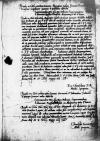Letter #6159
Sigismund I Jagiellon to Ioannes DANTISCUS & Tiedemann GIESECracow (Kraków), 1546-07-17
Manuscript sources:
Prints:
| ||||||
Text & apparatus & commentary Plain text Text & commentary Text & apparatus
Reverendis in Christo Patribus, dominis
Reverendi in Christo Paters Domini.
Qui ad nos designati esse dicuntur ex terris nostris
Bene valeant.
Dat(ae) or Dat(um)⌈Dat(ae)Dat(ae) or Dat(um)⌉
Commissio sacrae


 APG, 333, 29, 12, f. 495r
APG, 333, 29, 12, f. 495r